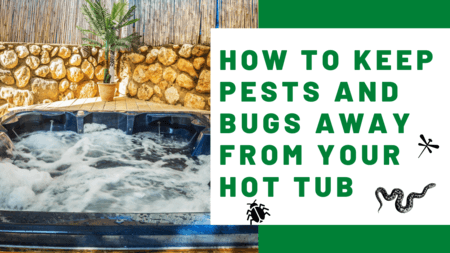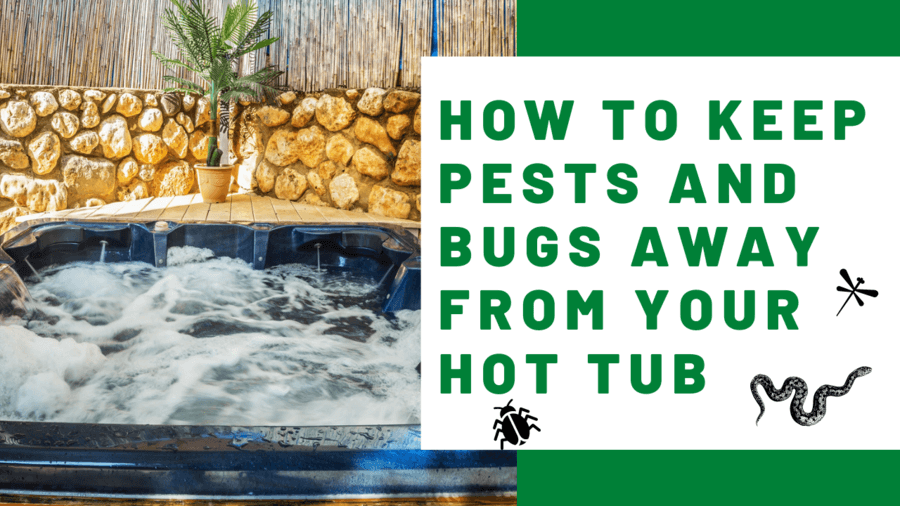
When I invested in a hot tub for my garden I have to admit that my last concern was flies and insects getting into the water. Yet, this summer, I’ve discovered just how much of a problem bugs and pests can be. Over the last few weeks I’ve been plagued by mosquitoes every time I’ve jumped into the hot tub, and it’s made me wonder what I could do to minimize the problem. I decided it was time to do some research so I could finally enjoy a relaxing soak in peace!
So, how to keep pests and bugs away from your hot tub. Keep the tub covered as much as possible to keep pests and bugs out. Make sure the hot tub water is correctly sanitized and consider planting certain flowers and plants around its perimeter to discourage insects from getting into the water. Not leaving food around the hot tub, clearing up standing water and keeping the surrounding garden tidy will help to discourage pests and bugs from the hot tub as well.
However, not all pests are insects. While mosquitoes, flies and other bugs commonly get into hot tubs, especially during the warmer months of the year, there are other pests that may be attracted to the water including mice, frogs, snakes and squirrels.
In this post, we’ll take a closer look at what can be done to prevent these issues from arising so that you can enjoy your hot tub without having to worry about what you’ll find whenever you jump in!
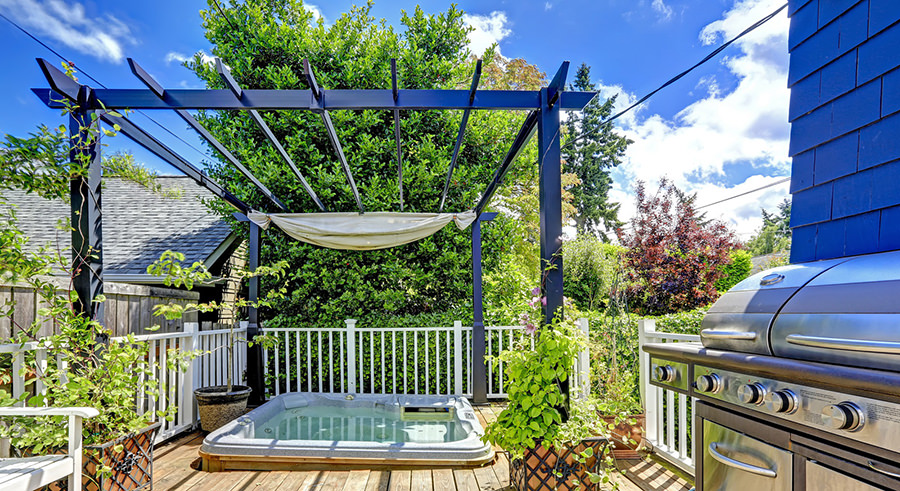
Why Do Hot Tubs Attract Pests?
It may seem odd that hot tubs attract pests but actually, when you think about it, it makes complete sense. After all, hot tubs feature all of the things that common household pests want and need. They have warmth, enclosed spaces and plenty of components that can be chewed and burrowed into. It’s no wonder, then, that snakes, bugs, rats, mice, squirrels and insects make a beeline for them.
Rodents and snakes like to hide without being detected in warm spaces. This makes hot tubs an ideal hiding spot. The problem can arise in the first place because humans around the hot tub leave discarded crumbs and food that can then attract rodents. Rodents attract snakes and so the pest infestation begins. Meanwhile, the mere presence of water often attracts an ant or wasp infestation.
Wherever there are humans, bugs and rodents are always nearby. In the summer months, you probably spend a lot of time in your garden close to your hot tub, making the most of your purchase. This means that you will probably be barbecuing or picnicking outdoors. There are bound to be leftovers after such outdoor feasts and pests will naturally come to see if they can feed on any of the scraps and crumbs.
During the winter months your hot tub won’t be safe from pest activity either. During cold weather, pests are often attracted to the moisture and warmth of a hot tub. They enjoy nesting inside insulation while moisture gives sustenance to these creatures. Ants can be a particular issue in this regard, especially if you have a wood surrounding to your hot tub.
In particular, Carpenter ants are attracted to rotten, old wood since it is easy to burrow into. When hot tubs are installed on decking, water may become trapped under the tub and, without a high-quality varnish coating, rot may set in. This will attract ants to the area. If there are logs, trees, roots and tree stumps in the area immediately around your hot tub, ants will also be attracted to these, so this is something to consider when choosing a location for your outdoor hot tub.
Slugs and snails are also likely to be attracted to hot tubs because of their love of shady and moist areas. Unfortunately, they can damage your plants while also being an unpleasant bathing companion. Slugs and snails are more active during the night when the conditions are damp and cool, however, you may also see them during the daytime hiding in shady, cool sites.
While hot tubs are warmer, the damp conditions they provide are more appealing than warm and dry air on a summer’s day. Luckily, you can use copper as a deterrent for these creatures. Available in tape or strip form, it can be bought at garden supplies stores and applied along the bottom of the tub to prevent them from getting in.
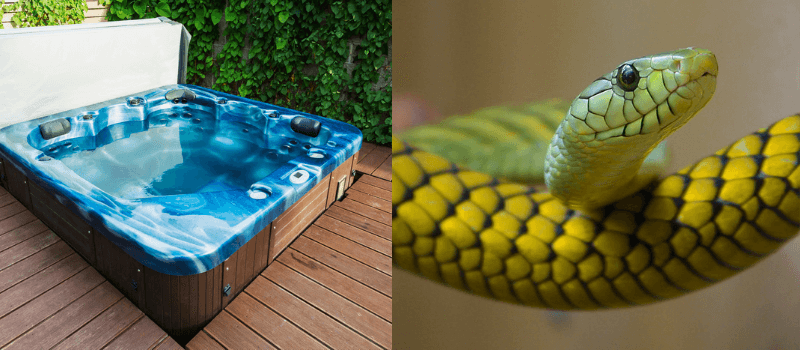
Are Snakes Attracted To Hot Tubs?
You may be surprised to discover that snakes are just one of the many pests that may be attracted to your hot tub. Of course, they aren’t attracted by the tub or the water itself but rather by the rodent activity which tends to take place around hot tubs since rodents are a natural source of food for snakes.
Snakes come into the garden looking for food, with the kind of snake being dependent on where you’re located. However, if rodents are inhabiting or visiting the area around your spa it’s likely that you’ll experience a snake problem at some point. If you’re able to keep rodents from coming near your hot tub, you’ll find that snakes will be less likely to make their home there too.
There are also some plants that are known to attract snakes since they prefer low ground covering plants like vines, myrtle, and vinca. Any plant that spreads over large areas of the garden will allow snakes to be undetected while searching for their prey. Also, long grass helps snakes to get the protection they need while hunting.
You should, therefore, take care which kind of plants you have in your garden, and particularly in the immediate vicinity of your hot tub, and take care to keep the grass as short as possible so there are few places for snakes to hide.
Snakes like to hide in hollow tree stumps, rock gardens and log piles. As they are cold-blooded they’re unable to regulate their temperature in the same way as warm-blooded creatures and therefore they have to find some shelter from both the cool night air and the midday sun. If you keep rocks, logs and tree stumps to a minimum in your garden you’re less likely to find that you’ve developed a snake problem.
If you do find you have a snake infestation in your hot tub, there are certain steps you can take.
Firstly, you should always make sure that your hot tub’s cover is left on whenever you’re not actually actively using the tub. You should also ensure the cover fits properly and is in good condition. Since snakes come to your hot tub area looking for rodents to eat you can take steps to prevent snakes from getting into the tub by keeping mice and rats away with traps or poison placed behind the hot tub’s panels.
There are also some commercially available products that can deter snakes from entering your garden, although you may find that some common household items can be equally effective in deterring them. Snakes don’t use their sense of smell to find their prey. Rather, they use taste – using their tongue to taste the air around them.
This means that you can use things that have a pungent odor to deter them. Some popular choices include crushed garlic cloves in oil, naphthalene (found usually in mothballs), and essential oils like cinnamon, cedarwood, cloves and eugenol in small pots placed around the area. You can also plant wormwood, lemongrass or thorny bushes near your hot tub to deter snakes and prevent them from climbing posts.
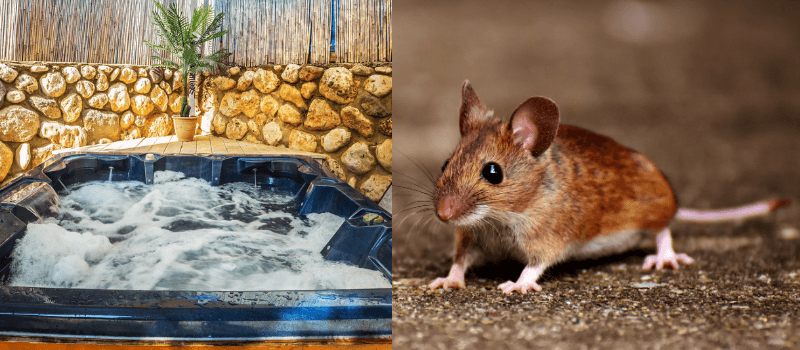
Will My Hot Tub Attract Mice Or Rats?
As we’ve already pointed out, hot tubs don’t attract mice or rats themselves, but food particles left around the area will encourage them to come to your hot tub to find food. If you drop any edible items or crumbs around the hot tub area and fail to thoroughly clean them up, rodents will inevitably follow.
All too often, you won’t realise that you’re experiencing a rodent infestation until a problem develops, such as the hot tub heater suddenly stops working. This can be caused by mice or rats chewing through the wiring. Rodents, and especially rates, enjoy chewing the vinyl casing that is wrapped around the hot tub’s wiring, and often they come up from below decking to chew on the wires in the cabinet. Therefore, if you discover that your tub suddenly is failing to heat up, it’s possible that rodents could be the source of the issue.
You can try to prevent rodents from being attracted to your hot tub by avoiding eating in the vicinity and cleaning up any crumbs or fallen food items that do end up on the ground around your spa. However, if you end up with a rat or mice infestation, you can use traps or poison placed safely behind the hot tub’s panels. You may also be able to seal the gaps surrounding the panels carefully so that rodents can’t get in.
The use of metallic meshes to block gaps may help since rodents cannot chew through them. If you have a raised hot tub on decking, using metallic mesh around its sides is always the best solution since mice cannot chew through it in the same way as they can chew through plastic or wood.
Also, if you have decking with open slats around your hot tub you can underline it using metallic mesh. Otherwise, food will inevitably drop between the planks and this will, in turn, attract vermin who will nest in the space and raise large families.
Remember that mice are capable of getting through even very small holes, so whenever you’re sealing around joints and cabinets it’s important to ensure you do the job thoroughly and completely to avoid problems in the future.
If you’re in doubt about what to do about a mice or rat infestation you can always call a professional pest control expert to deal with the issue. This is especially likely to be the best course of action if there are large numbers of rodents, but if you only find a couple you can probably deal with the issue yourself with traps.
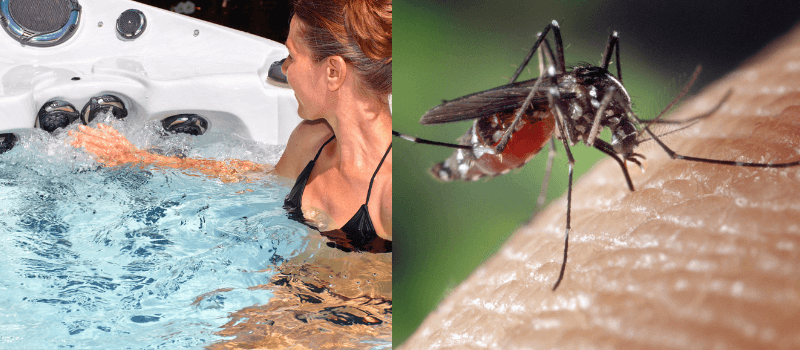
How To Keep Flying Insects Away From My Hot Tub
There are many different types of flying insect that may be attracted to your hot tub. While mosquitoes may be especially irritating, flies and wasps can also be a major problem.
Flying insects, and especially mosquitoes, love humidity, water, and large groups of humans, so it makes sense that they would be attracted to the hot tub. It’s best to take a preventative approach when it comes to flying insects around your spa since it’s harder to get rid of mosquitoes and other flying pests once they have become established than to stop them from visiting it in the first place.
Firstly, you should be careful to avoid any stagnant and standing water in the vicinity of your hot tub. After a rainfall, check your garden and look for any places where water may linger. Buckets, old tyres and depressions in the garden may all fill up with water during a storm and this will end up attracting mosquitoes and flying insects over time.
If there are sources of water that cannot be emptied like fountains or wading pools, make sure the water is changed once per week. Mosquitoes are unable to breed or develop when they are in moving water, therefore if you have water features like fountains, keeping them switched on and moving will keep them from infesting the area.
It also goes without saying that whenever you aren’t using your hot tub you should keep its cover on. While it isn’t likely that the water inside your spa will ever be truly still it is still inviting to flying insects that are looking for somewhere to lay their eggs. Keeping a lid or cover firmly over the water whenever you aren’t in it will prevent this from happening.
You should also make sure that your garden is tidy and free from anything that could attract flying pests. Mosquitoes especially love rotting logs, wet, tall grass and piles of wet leaves. You should make sure to mow your lawn on a regular basis and to rake up any fallen leaves and dispose of them to prevent mosquito infestations from setting in.
It’s especially important to pay close attention to any areas that remain moist, for example underneath decking. If you can keep such areas free of any organic debris the water will effectively either evaporate or drain away into the ground before there is time for it to become home to the mosquito larvae.
One further thing you can do is to keep the hot tub filled with clean and properly balanced water that is turned over each day by the water pump to prevent mosquitoes and flying insects from being attracted to it. It’s essential to maintain your spa properly by cleaning the skimmer and filter on a regular basis and to create and adhere to a proper schedule for maintenance so you can be confident the tub will remain clear, clean and free from any pests.
Another consideration when trying to deter flying pests like mosquitoes is to keep a fan running, especially when you’re using the tub yourself and don’t want to be pestered or bitten. Mosquitoes are unable to fly near or against a fan. This is why large fans kept in use will keep them away.
Wasps are another problem that can occur around hot tubs, but there are solutions to resolve this problem too. You can deter wasps from flying around your tub by planting wormwood, eucalyptus or mint nearby. There are also commercially available wasp traps that can be purchased and placed inside the hot tub’s interior behind its panels.
Unfortunately, wasps and bees require water to survive, so this makes your hot tub very attractive to them. They are able to enter the motor cabinet and can get under raised decking in which a spa has been installed, finding their way through cracks and openings to build their hives and nests. Once they have become established they’re very difficult to eliminate.
Since these insects have a vital part to play in our ecosystem it’s not ideal to kill them off. However, nobody wants to be stung while bathing in their spa. This is why deterring them is the best course of action. One way to do this is to burn coffee granules in an aluminium tray or dish. Alternatively, you can make a mixture of white vinegar and water to use as a deterrent spray. There are other household items that can also deter these flying creatures including WD-40 and hairspray.
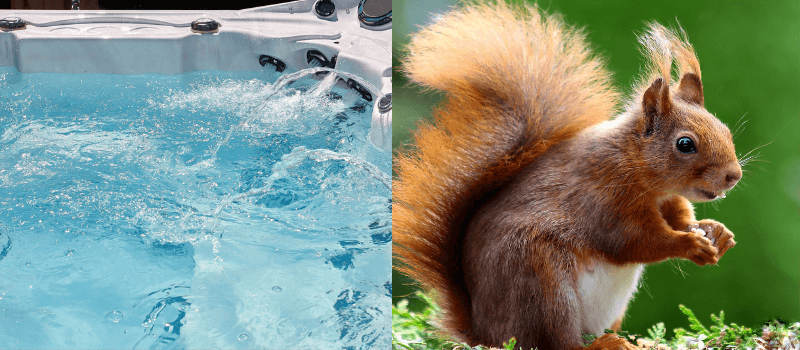
How Do I Deter Frogs And Squirrels From Getting Into My Hot Tub?
Two more unusual creatures that are attracted to hot tubs are frogs and squirrels. If you are living in a humid environment you may find that frogs are a persistent problem. Frogs always look for warm places to rest so hot tubs represent the ideal spot. If you haven’t covered your tub or if your cover isn’t tightly fitted, frogs can get into the water inside.
Often, the frogs will die in the water, but even if they survive they will probably have gone to the bathroom in the water, so you’ll need to clean up the mess and replace the water to ensure that it’s clean and safe for use by humans. Frogs will also be less attracted to hot tub water that has been properly balanced with chemicals and which has the correct level of sanitizer. If you take the time to ensure your water chemistry is well maintained you’ll have less chance of suffering from a frog infestation.
Squirrels are another unexpected pest that can cause problems around hot tubs. This is especially likely to be the case if you have a wooden surround to your tub. Squirrels will be encouraged to chew the wood around the hot tub and, in turn, this can lead to them accidentally chewing through the wiring and causing major damage.
It’s possible to purchase commercially available squirrel deterrents at garden centres and hardware stores however, these often have a strong odour which can affect your enjoyment of your tub. It’s therefore best to make sure that the entire hot tub enclosure is covered in a steel mesh or other metal cage so that squirrels are unable to chew through it and cause damage.
Which Plants Can Keep Bugs Away From The Hot Tub?
If you’re experiencing an issue with bugs around your hot tub there are several plants that can be placed around it to deter insect activity. Arranging potted plants and in-ground plants around the hot tub and the patio or decking surrounding it will help. One of the best is citronella. Known for its deterring effects on flying insects and especially mosquitoes, this plant can grow to be quite large, even when it is in a pot, and its attractive pink flowers make it an appealing choice if you want to create a beautiful surrounding for your spa.
Another good choice of plant is rosemary. Not only is it a delicious herb to add to your meals, it also helps to deter carrot flies, cabbage moths and mosquitoes. It is also small enough to grow in a pot around your tub and it has a pleasant odour.
If you prefer flowers to herbs you may find that petunias are just the thing for your hot tub area. Although they require minimal maintenance, they grow large flowers in a lot of different colours. They also ward off a host of unwanted pests and bugs including asparagus beetles, aphids and leafhoppers. Geraniums too are known for repelling mosquitoes, with the Pelargonium Citrosum being particularly effective in this respect.
One more type of plant that is ideal for growth around your hot tub is lavender. Flies and mosquitoes aren’t fans of this fragrant plant, but humans love it and thanks to its relaxing properties it’s perfect for your spa area.
Related Questions
How do I choose a tightly fitting cover for my hot tub? A cover is an absolute essential for any hot tub. Not only does it insulate it and help to keep the water at the right temperature for longer but it also protects the water from pollen, dirt, debris and pests that could get into it if the tub was left open to the elements.
Finding a tightly fitting cover is, therefore, imperative so you need to do your research well. Compare the various options and make sure that you’ve measured your spa properly. You need to make sure that you haven’t chosen a cover that is too large or too small. You also need to get the right fit on the corners so that the skirting will be tights along the hot tub’s entire perimeter.
Not only do you need a well-fitting cover, you also need to choose a cover made from high-quality material that is capable of withstanding the elements. It needs to stand up against UV rays, snow, rain and wind and it must also be a deterrent to pests. A vinyl cover is an ideal choice and it will be simple to maintain.
How do I check my hot tub for any damage caused by pests? It’s important to regularly check your hot tub and its components for any damage that may have been caused by pests (or indeed, for any other damage). You should carry out a weekly visual inspection of your tub’s exterior, especially if it is inset into decking or has a wooden surround.
Look for any evidence of bite marks or gnawing that would indicate that pests such as squirrels are biting at the wood. You should also check for any persistent damp patches in wooden surrounds as these could be home to carpenter ants. Make sure that you check the decking surrounding your tub if applicable to make sure that no pests are lurking beneath the planks. You should fill in any gaps that you find with a metallic mesh to prevent mice, rats, bees or wasps from getting in.
You should also take the time to check inside the hot tub cabinet where the wiring is located. You should look for any evidence of nest building that could indicate that rodents such as mice or rats are making their home inside the cabinet. You should also check the wires for any indication of fraying that could suggest that they are being chewed by pests.
If you detect any damage of this nature you should take immediate steps to eradicate the pests that are causing the problem and to repair any damage that has already been caused before a more serious problem occurs. You may need to call in a professional hot tub engineer to carry out these repairs since it’s always wise to avoid carrying out this kind of maintenance by yourself unless you have specialist skills in this area.

